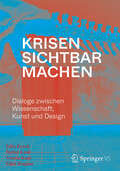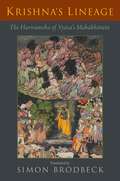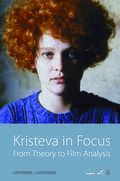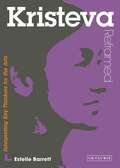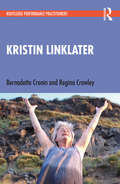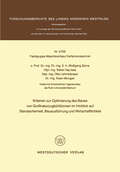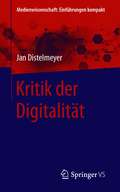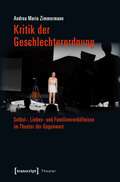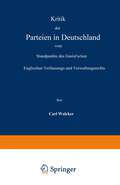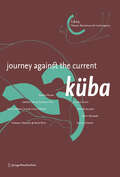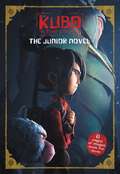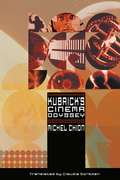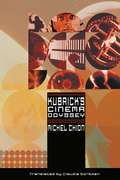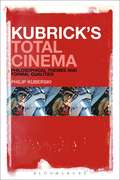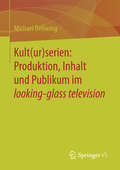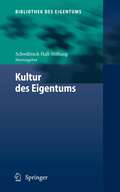- Table View
- List View
Krisen sichtbar machen: Dialoge zwischen Wissenschaft, Kunst und Design
Krisen sichtbar machen führt unterschiedliche Dialoge zwischen Wissenschaft, Kunst und Design fort, welche die Grundlage des interdisziplinären Ausstellungsprojektes Making Crises Visible im Senckenberg Naturmuseum waren. Den Reflexionen dieser Ausstellung wird nun ein zusätzlicher, das Spektrum in Theorie und Praxis weiter aufspannender Rahmen gegeben. Der Band nimmt damit die in allen Disziplinen wichtiger werdende Debatte über neue Formen der Wissensgenerierung, der Wissens- sowie Wissenschaftskommunikation auf - und fragt nach dem Beitrag, den diese zur Bewältigung politischer, ökonomischer und ökologischer Krisen leisten können. Die produktive Vielfalt der Ansätze und Erkenntnisformen spiegelt sich in den unterschiedlichen Formaten und Perspektiven, die er vereint.
Krishna's Lineage: The Harivamsha of Vyasa's Mahabharata
by Simon BrodbeckForming the final part of the Sanskrit Mahabharata, the Harivamsha's main business is to supply narrative details about the great god Vishnu's avatar Krishna Vasudeva, who has been a comparatively minor character in the previous parts of the Mahabharata, despite having taken centre stage in the Bhagavad Gita. Krishna is born in Mathura (some 85 miles south of present-day Delhi). As an infant he is smuggled out of Mathura for his own safety. He and his brother Baladeva grow up among cowherds in the forest, where between them they perform many miraculous deeds and kill many dangerous demons, before returning to Mathura where they kill the evil King Kamsa and his cronies. Thereafter, Krishna is the hero and unofficial leader of his people the Yadava-Vrishnis. When Mathura is besieged by enemies, Krishna leads his people to abandon the town and migrate west, founding the dazzling new city of Dvaraka by the sea. Krishna then repeatedly travels away from that base repeatedly to perform heroic deeds benefitting those in need - including his own people, his more immediate family, and the gods. After narrating the stories of Krishna, the Harivamsha ends by finishing the story of Janamejaya with which the Mahabharata began. The Harivamsha is a powerhouse of Hindu mythology and a classic of world literature. It begins by contextualising Vishnu's appearance as Krishna in several ways, in the process presenting a variety of cosmogonical, cosmological, genealogical, mythological, theological, and karmalogical materials. It then narrates Krishna's birth and adventures in detail. Presenting a wide variety of exciting stories in a poetic register that makes extensive use of natural imagery, the Harivamsha is a neglected literary gem and an ideal starting-point for readers new to Indian literature.
KRISHNA'S LINEAGE C: The Harivamsha of Vyasa's Mahabharata
by Simon BrodbeckForming the final part of the Sanskrit Mahabharata, the Harivamsha's main business is to supply narrative details about the great god Vishnu's avatar Krishna Vasudeva, who has been a comparatively minor character in the previous parts of the Mahabharata, despite having taken centre stage in the Bhagavad Gita. Krishna is born in Mathura (some 85 miles south of present-day Delhi). As an infant he is smuggled out of Mathura for his own safety. He and his brother Baladeva grow up among cowherds in the forest, where between them they perform many miraculous deeds and kill many dangerous demons, before returning to Mathura where they kill the evil King Kamsa and his cronies. Thereafter, Krishna is the hero and unofficial leader of his people the Yadava-Vrishnis. When Mathura is besieged by enemies, Krishna leads his people to abandon the town and migrate west, founding the dazzling new city of Dvaraka by the sea. Krishna then repeatedly travels away from that base repeatedly to perform heroic deeds benefitting those in need - including his own people, his more immediate family, and the gods. After narrating the stories of Krishna, the Harivamsha ends by finishing the story of Janamejaya with which the Mahabharata began. The Harivamsha is a powerhouse of Hindu mythology and a classic of world literature. It begins by contextualising Vishnu's appearance as Krishna in several ways, in the process presenting a variety of cosmogonical, cosmological, genealogical, mythological, theological, and karmalogical materials. It then narrates Krishna's birth and adventures in detail. Presenting a wide variety of exciting stories in a poetic register that makes extensive use of natural imagery, the Harivamsha is a neglected literary gem and an ideal starting-point for readers new to Indian literature.
Kristeva in Focus: From Theory to Film Analysis (Berghahn Ser.)
by Katherine J. GoodnowDealing with some of the major themes in film narratives, this book draws on the theories of French psychoanalyst Julia Kristeva. It looks at how narratives have changed over time, and considers the sources of our variable reactions to themes and representations of horror, strangers, and love. In addition to a selection of contemporary mainstream films, the major films for analysis are New Zealand “New Wave” films such as Alison Maclean’s Kitchen Sink and Crush; Vincent Ward’s Vigil; and Jane Campion’s Sweety, An Angel at My Table, and The Piano.
Kristeva in Focus: From Theory to Film Analysis
by Katherine J. GoodnowDealing with some of the major themes in film narratives, this book draws on the theories of French psychoanalyst Julia Kristeva. It looks at how narratives have changed over time, and considers the sources of our variable reactions to themes and representations of horror, strangers, and love. In addition to a selection of contemporary mainstream films, the major films for analysis are New Zealand “New Wave” films such as Alison Maclean’s Kitchen Sink and Crush; Vincent Ward’s Vigil; and Jane Campion’s Sweety, An Angel at My Table, and The Piano.
Kristeva Reframed: Interpreting Key Thinkers for the Arts (Contemporary Thinkers Reframed)
by Estelle BarrettFor Kristeva, in a world immersed in readymade images, art or aesthetic experience is a practice that constitutes both a subject (a sense of self) and an object that is able to transform meaning and consciousness. Kristeva Reframed examines key ideas in Kristeva's work to show how they are most relevant to artists, and how they can be applied in interpreting artworks. With examples from the paintings of van Gogh and Picasso, the work of contemporary eminist painters, the photography of Bill Henson and the film and animation work of Van Sowerine, Estelle Barrett demonstrates how Kristeva can lluminate the relationships between artist and art object, between artists, artworks and audiences, and between art and knowledge. Through these relationships she explores what Kristeva's work reveals about the role and function of art in society and offers a smooth passage through Kristeva's ideas and her relevance to visual culture.
Kristin Linklater (Routledge Performance Practitioners)
by Bernadette Cronin Regina CrowleyKristin Linklater is one of the most internationally recognised names in the field of voice training, and this volume explores her work and life whilst also putting her work into practice. Charting the development of Linklater's process, including her work at LAMDA, the Lincoln Centre, NYU, Columbia, and the KLVC on Orkney, the book provides a comprehensive overview of one of the world’s leading voice coaches. This book contains: A detailed biography of Linklater’s life, including her work with Iris Warren at LAMDA, as well as the founding of her own companies and the KLVC on Orkney. Detailed analysis of her key text, Freeing the Natural Voice, and her work with Carol Gilligan on The Company of Women, an all-female Shakespeare company they co-conceived. A comprehensive set of exercises – several of these previously unpublished. This book offers essential reading and an invaluable practice handbook to the contemporary performer, voice teacher, and actor trainer. As a first step towards critical understanding, and as an initial exploration before going on to further, primary research, Routledge Performance Practitioners offer unbeatable value for today’s student.
Kristin Linklater (Routledge Performance Practitioners)
by Bernadette Cronin Regina CrowleyKristin Linklater is one of the most internationally recognised names in the field of voice training, and this volume explores her work and life whilst also putting her work into practice. Charting the development of Linklater's process, including her work at LAMDA, the Lincoln Centre, NYU, Columbia, and the KLVC on Orkney, the book provides a comprehensive overview of one of the world’s leading voice coaches. This book contains: A detailed biography of Linklater’s life, including her work with Iris Warren at LAMDA, as well as the founding of her own companies and the KLVC on Orkney. Detailed analysis of her key text, Freeing the Natural Voice, and her work with Carol Gilligan on The Company of Women, an all-female Shakespeare company they co-conceived. A comprehensive set of exercises – several of these previously unpublished. This book offers essential reading and an invaluable practice handbook to the contemporary performer, voice teacher, and actor trainer. As a first step towards critical understanding, and as an initial exploration before going on to further, primary research, Routledge Performance Practitioners offer unbeatable value for today’s student.
Kriterien zur Optimierung des Baues von Großnaturzugkühltürmen im Hinblick auf Standsicherheit, Bauausführung und Wirtschaftlichkeit (Forschungsberichte des Landes Nordrhein-Westfalen #2726)
by Wolfgang ZernaKritik der Digitalität (Medienwissenschaft: Einführungen kompakt)
by Jan DistelmeyerDie Auseinandersetzung mit Digitalität gehört zu den dringlichsten Herausforderungen der Gegenwart. Die zunehmende Bedeutung und Ausbreitung von Computertechnologie fordert nicht nur Gesellschaften und Individuen heraus – diese Entwicklung setzt auch das Konzept der Digitalität unter Druck, das die Gesamtheit und Eigenart der Bedingungen und Folgen elektronischer Digitalcomputer (in all ihren Formen) zu fassen versucht. Gerade weil jedoch Digitalität alltäglich ist, sollte es ihre Kritik, ihre Analyse und Beurteilung, auch sein.Wie kann eine Analyse sowohl grundsätzlichen Charakteristika als auch sich wandelnden konkreten Formen, Infrastrukturen und Praktiken gerecht werden? Wie prägen die Entwicklungen einer Digitalisierung, die Formen von Vernetzung, Einbettung und Autonomisierung programmatisch umfasst, Medien, Kulturen und Gesellschaften? Wie verhalten sich „künstliche Intelligenz“ und „algorithmische Regierung“ zueinander, wie passt die Immaterialität "des Digitalen" zur Materialität der Computer? Wie vermittelt sich der im Wandel begriffene Status und Wirkungsbereich dieser Technik?Dieser Band führt in laufende Debatten ein und entwickelt einen eigenen Ansatz zur Kritik der Digitalität, der nach Formen von Interfaces und Prozessen des Leitens fragt.
Kritik der Geschlechterordnung: Selbst-, Liebes- und Familienverhältnisse im Theater der Gegenwart (Theater #82)
by Andrea Maria ZimmermannWie zeigt sich im Theater der Gegenwart das Private als politisch? Wie ist in diesem Zusammenhang feministische Kritik möglich? An der Schnittstelle von Literaturwissenschaft und Gender Studies analysiert Andrea Maria Zimmermann bisher eher unbekannte, aber thematisch und ästhetisch besonders reizvolle deutschsprachige Theatertexte aus den Jahren 2000 bis 2010. Aus einer queer-feministischen Perspektive entwickelt sie in Anlehnung an Luce Irigaray und Judith Butler ein Konzept von Kritik als dreifache Bewegung aus Rekonstruktion, Dekonstruktion und Utopie: das Spiel der Mimesis. In einem faszinierenden Dialog zwischen Theorie, Methode und Material fordert die Studie dazu auf, das zeitdiagnostische und politische Schreiben zeitgenössischer Theaterautor_innen zu entdecken.
Kritik der Parteien in Deutschland vom Standpunkte des Gneist’schen Englischen Verfassungs- und Verwaltungsrechts
by Carl WalckerKüba: Journey Against the Current
by Thyssen-Bornemisza Art ContemporaryDuring May and June 2006, artist Kutlug Ataman’s award-winning film installation Küba is travelling aboard the Negrelli, a converted container barge, up the Danube River from the Black Sea to Vienna. Slowly, against the current, Küba will navigate Europe’s oldest trade route and cultural artery through Romania, Bulgaria, Serbia and Montenegro, Croatia, Hungary, and Slovakia to its heart in Austria. At each stop, in each country, a new work specifically commissioned by Thyssen-Bornemisza Art Contemporary is presented in dialogue with Ataman’s installation. Matei Bejenaru, Nedko Solakov, Zelimir Zilnik, Renata Poljak, László Csáki and Szabolcs Pálfi, Anetta Mona Chisa and Lucia Tkácová, Emanuel Danesch and David Rych speak in different tongues through their individual artistic projects about minorities, invisible communities, their migrations, histories and memories, and the survival skills learnt to protect their identity and self-representation. Küba: Journey Against the Current is a local and international project intended to provide an artistic response to the complex challenges presented by recent socio-political developments In Europe.
Kubo and the Two Strings: The Junior Novel
by Sadie ChesterfieldA junior novel based on the animated movie, Kubo and the Two Strings!©2016 LAIKA Entertainment. All Rights Reserved.
Kubrick and Control: Authority, Order and Independence in the Films and Working Life of Stanley Kubrick (Stanley Kubrick Studies)
by Jeremy CarrKubrick and Control is an examination of authority, order, and independence in the films directed by Stanley Kubrick, as well as in his personal life and working habits. This study explores the ways in which these central preoccupations develop and reformulate through the course of Kubrick's career, as he moved from genre to genre and shifted stories, locations, time periods, scope, and technical facilities. Separating the productions in accordance to their wider filmic classifications, the individual chapters examine a variety of productions, allowing for a categorical as well as a developmental approach to the works. In addition, following concurrently with each individual film discussed, details about Kubrick's life and evolving directorial practice are recounted in relation to these same concerns. In studying the stylistic and narrative features of his work, examples illustrate how Kubrick took these themes and applied them consistently yet with significant variation, manifest in relation to mise-en-scène construction (how Kubrick composed his images); characterization (individuals establishing, exerting, seeking, and/or abusing their authority); narrative (stories about characters and situations dependent upon order and control); and the actual filmmaking processes of the director (Kubrick was both praised and damned for his authorial management and obsession with order and perfection).
Kubrick's Cinema Odyssey
by Michel ChionAuthor wrote bestselling bfi Publishing title David Lynch 'a joy to the reader of film criticism' Choice; 2001: A Space Odyssey to be re-released in cinemas in The Spring and highly likely to be the focus of much media attention in the new year; Stanley Kubrick's 2001: A Space Odyssey (1968), based on Arthur C Clarke's novel, is one of the most ambitious films ever made, an epic of space exploration that takes in the whole history of humanity (as well as speculation about its future). A technical triumph that stands up today 2001 is topical also because of its meditation on the relationship between man, animal and machine. Haunting and enigmatic, it's a film that contains myriad images that seem to defy any explanation. In this multilayered study, acclaimed critic and theorist of film sound Michel Chion offers some keys to understanding 2001. Setting the film first in its historical and cultural contexts (the Space Race, the Cold War, 1960s psychedelia), Chion goes on to locate it within Kubrick's career. He then conducts a meticulous and subtle analysis of its structure and style, arguing that 2001 is an 'absolute film', a unique assemblage of cinema's elements, through which pulses a vision of human existence. 'Animals who know they will die, beings lost on earth, forever caught between two species, not animal enough, not cerebral enough.' In a supplementary chapter Chion argues that Kubrick's last film, Eyes Wide Shut (1999), is a return to 2001, a final statement of its concerns. And in a series of appendices Chion provides production details, an analytic synopsis, credits and a consideration of the legacy of 2001.
Kubrick's Cinema Odyssey
by Michel ChionAuthor wrote bestselling bfi Publishing title David Lynch 'a joy to the reader of film criticism' Choice; 2001: A Space Odyssey to be re-released in cinemas in The Spring and highly likely to be the focus of much media attention in the new year; Stanley Kubrick's 2001: A Space Odyssey (1968), based on Arthur C Clarke's novel, is one of the most ambitious films ever made, an epic of space exploration that takes in the whole history of humanity (as well as speculation about its future). A technical triumph that stands up today 2001 is topical also because of its meditation on the relationship between man, animal and machine. Haunting and enigmatic, it's a film that contains myriad images that seem to defy any explanation. In this multilayered study, acclaimed critic and theorist of film sound Michel Chion offers some keys to understanding 2001. Setting the film first in its historical and cultural contexts (the Space Race, the Cold War, 1960s psychedelia), Chion goes on to locate it within Kubrick's career. He then conducts a meticulous and subtle analysis of its structure and style, arguing that 2001 is an 'absolute film', a unique assemblage of cinema's elements, through which pulses a vision of human existence. 'Animals who know they will die, beings lost on earth, forever caught between two species, not animal enough, not cerebral enough.' In a supplementary chapter Chion argues that Kubrick's last film, Eyes Wide Shut (1999), is a return to 2001, a final statement of its concerns. And in a series of appendices Chion provides production details, an analytic synopsis, credits and a consideration of the legacy of 2001.
Kubrick's Mitteleuropa: The Central European Imaginary in the Films of Stanley Kubrick
by Nathan Abrams Jeremi SzaniawskiStanley Kubrick was arguably one of the most influential American directors of the post-World War II era, and his Central European Jewish heritage, though often overlooked, greatly influenced his oeuvre. Kubrick's Mitteleuropa explores this influence in ways that range from his work with Hungarian and Polish composers Bela Bartok, György Ligeti, and Krzysztof Penderecki to the visual inspiration of artists such as Egon Schiele, Gustav Klimt, and other central European Modernists. Beyond exploring the Mitteleuropa sensibility in Kubrick's films, the contributions in this volume also provide important commentary on the reception of his films in countries across Eastern Europe.
Kubrick's Mitteleuropa: The Central European Imaginary in the Films of Stanley Kubrick
by Nathan Abrams Jeremi SzaniawskiStanley Kubrick was arguably one of the most influential American directors of the post-World War II era, and his Central European Jewish heritage, though often overlooked, greatly influenced his oeuvre. Kubrick's Mitteleuropa explores this influence in ways that range from his work with Hungarian and Polish composers Bela Bartok, György Ligeti, and Krzysztof Penderecki to the visual inspiration of artists such as Egon Schiele, Gustav Klimt, and other central European Modernists. Beyond exploring the Mitteleuropa sensibility in Kubrick's films, the contributions in this volume also provide important commentary on the reception of his films in countries across Eastern Europe.
Kubrick's Mitteleuropa: The Central European Imaginary in the Films of Stanley Kubrick
by Nathan Abrams Jeremi SzaniawskiStanley Kubrick was arguably one of the most influential American directors of the post-World War II era, and his Central European Jewish heritage, though often overlooked, greatly influenced his oeuvre. Kubrick's Mitteleuropa explores this influence in ways that range from his work with Hungarian and Polish composers Bela Bartok, György Ligeti, and Krzysztof Penderecki to the visual inspiration of artists such as Egon Schiele, Gustav Klimt, and other central European Modernists. Beyond exploring the Mitteleuropa sensibility in Kubrick's films, the contributions in this volume also provide important commentary on the reception of his films in countries across Eastern Europe.
Kubrick's Total Cinema: Philosophical Themes and Formal Qualities
by Philip KuberskiWhatever people think about Kubrick's work, most would agree that there is something distinctive, even unique, about the films he made: a coolness, an intellectual clarity, a critical edginess, and finally an intractable ambiguity. In an attempt to isolate the Kubrick difference, this book treats Kubrick's films to a conceptual and formal analysis rather than a biographical and chronological survey. As Kubrick's cinema moves between the possibilities of human transcendence dramatized in 2001: A Space Odyssey and the dismal limitations of human nature exhibited in A Clockwork Orange, the filmmaker's style "de-realizes" cinematic realism while, paradoxically, achieving an unprecedented frankness of vision and documentary and technical richness. The result is a kind of vertigo: the audience is made aware of both the de-realized and the realized nature of cinema. As opposed to the usual studies providing a summary and commentary of individual films, this will be the first to provide an analysis of the "elements" of Kubrick's total cinema.
Kubrick's Total Cinema: Philosophical Themes and Formal Qualities
by Philip KuberskiWhatever people think about Kubrick's work, most would agree that there is something distinctive, even unique, about the films he made: a coolness, an intellectual clarity, a critical edginess, and finally an intractable ambiguity. In an attempt to isolate the Kubrick difference, this book treats Kubrick's films to a conceptual and formal analysis rather than a biographical and chronological survey. As Kubrick's cinema moves between the possibilities of human transcendence dramatized in 2001: A Space Odyssey and the dismal limitations of human nature exhibited in A Clockwork Orange, the filmmaker's style "de-realizes" cinematic realism while, paradoxically, achieving an unprecedented frankness of vision and documentary and technical richness. The result is a kind of vertigo: the audience is made aware of both the de-realized and the realized nature of cinema. As opposed to the usual studies providing a summary and commentary of individual films, this will be the first to provide an analysis of the "elements" of Kubrick's total cinema.
Kult(ur)serien: Produktion, Inhalt und Publikum im looking-glass television
by Michael DellwingDie Serie ist mittlerweile zum zentralen Element der Gegenwartskultur geworden. Damit hat sie dem Fernsehen, das einst belächeltes und herabgewertetes Medium war, kulturelle Bedeutung und im „Quality TV“ eine Rolle als künstlerische Leistung verschafft.Der vorliegende Band steht auf der Basis dieser Entwicklung. Er möchte nachzeichnen, in welchem Netz von Akteuren und deren aufeinander bezogenen Erwartungen die US-Serie und ihre künstlerische Anerkennung aufkommen. Dabei rückt er die Prozesse in den Vordergrund, in denen die Produktion unterstellen muss, was wirtschaftliche Abnehmer, Regulierungsbehörden und Publikum wahrscheinlich tun werden und zeigt auf, wie diese Akteure die Produktion in unterschiedlichen wirtschaftlichen Kontexten beurteilen und beeinflussen. Anhand zeitgenössischer Kult(ur)serien wird so die Entwicklung nachgezeichnet, die letztendlich zur modernen Form des seriellen Erzählens geführt hat.An die Stelle von Inhaltsanalysen, wie sie in der Fernsehforschung vermehrt aufgekommen sind, und Rezeptionsstudien, die die Erforschung von Medieninhalten zunehmend in den Raum des aufeinander bezogenen Handelns von Interpretationsgemeinschaften überführt haben, tritt hier eine Erforschung des „looking-glass-Fernsehens“, die zum Verständnis der Strukturen beitragen möchte, in denen modernes Serienfernsehen gemacht wird.
Kultur des Eigentums (Bibliothek des Eigentums #3)
by Schwäbisch Hall-StiftungDer dritte Band der Reihe "Bibliothek des Eigentums" regt dazu an, über das Grundthema Eigentum nachzudenken: seine Versprechungen und Gefährdungen. Die Kultur des Eigentums hat vielerlei Ausprägungen, von den ältesten wie Grund und Boden bis zu den neuesten wie Patentwesen und Copyright. Nichts davon ist abschließend gesichert, sondern muss Tag für Tag vertreten, gerechtfertigt und verteidigt werden. Dieses Buch beleuchtet die geistesgeschichtliche Lage der Gegenwart und lenkt den Blick auf die Zukunft. Nicht zufällig ist der Anlass der Entstehung dieses Bandes der 75. Geburtstag der Bausparkasse Schwäbisch Hall im Mai 2006.
Kultur - Erbe - Ethik: »Heritage« im Wandel gesellschaftlicher Orientierungen (Linzer Beiträge zur Kunstwissenschaft und Philosophie #12)
by Reinhard Kren Monika Leisch-KieslDer Umgang mit kulturellem Erbe ist eine weltweite Herausforderung, die durch länderspezifische Traditionen und Kontexte sowohl regional als auch global besondere Anforderungen stellt. Wilfried Lipp ist als Denkmalpfleger und Intellektueller für diesen Komplex eine zentrale Person und aktiv an Diskursen und Entwicklungen im Feld beteiligt. Internationale Expert*innen und Entscheidungsträger*innen sowie Persönlichkeiten aus Kultur, Medien und Politik widmen ihm Erörterungen und Analysen im Feld zwischen denkmalpflegerischen Aufgaben, kulturellen Identitäten und dynamischen Lebenswelten - und liefern damit einen umfassenden Einblick in die Heritage Studies.
